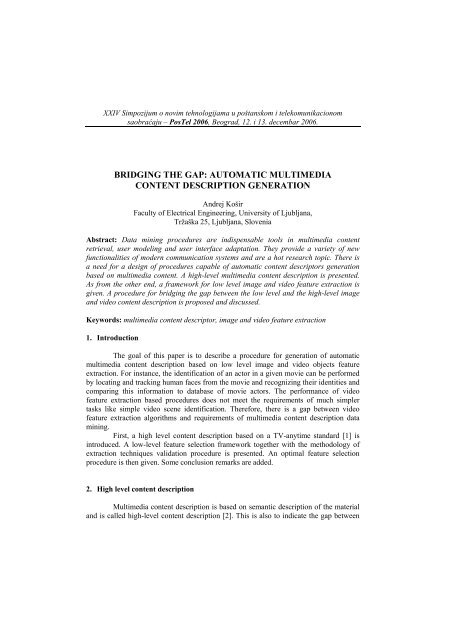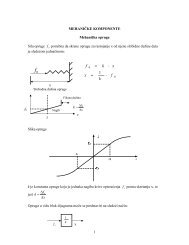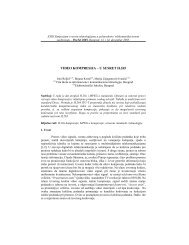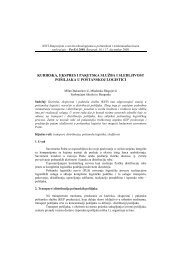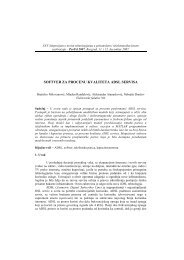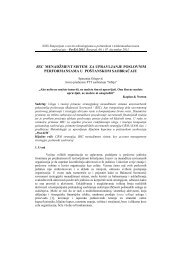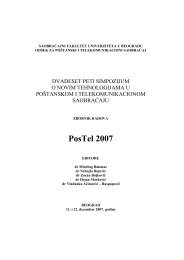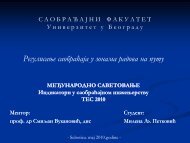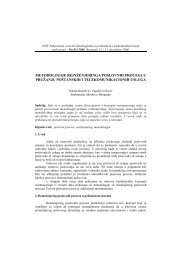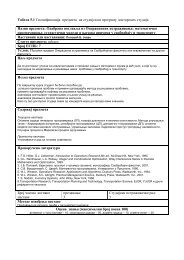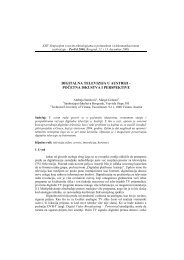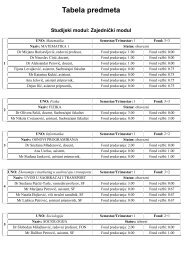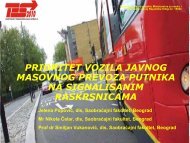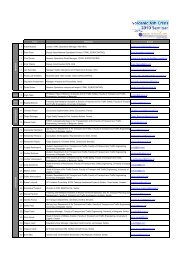uputstvo za autore - PosTel - Simpozijum o novim tehnologijama u ...
uputstvo za autore - PosTel - Simpozijum o novim tehnologijama u ...
uputstvo za autore - PosTel - Simpozijum o novim tehnologijama u ...
Create successful ePaper yourself
Turn your PDF publications into a flip-book with our unique Google optimized e-Paper software.
XXIV <strong>Simpozijum</strong> o <strong>novim</strong> <strong>tehnologijama</strong> u poštanskom i telekomunikacionom<br />
saobraćaju – <strong>PosTel</strong> 2006, Beograd, 12. i 13. decembar 2006.<br />
BRIDGING THE GAP: AUTOMATIC MULTIMEDIA<br />
CONTENT DESCRIPTION GENERATION<br />
Andrej Košir<br />
Faculty of Electrical Engineering, University of Ljubljana,<br />
Tržaška 25, Ljubljana, Slovenia<br />
Abstract: Data mining procedures are indispensable tools in multimedia content<br />
retrieval, user modeling and user interface adaptation. They provide a variety of new<br />
functionalities of modern communication systems and are a hot research topic. There is<br />
a need for a design of procedures capable of automatic content descriptors generation<br />
based on multimedia content. A high-level multimedia content description is presented.<br />
As from the other end, a framework for low level image and video feature extraction is<br />
given. A procedure for bridging the gap between the low level and the high-level image<br />
and video content description is proposed and discussed.<br />
Keywords: multimedia content descriptor, image and video feature extraction<br />
1. Introduction<br />
The goal of this paper is to describe a procedure for generation of automatic<br />
multimedia content description based on low level image and video objects feature<br />
extraction. For instance, the identification of an actor in a given movie can be performed<br />
by locating and tracking human faces from the movie and recognizing their identities and<br />
comparing this information to database of movie actors. The performance of video<br />
feature extraction based procedures does not meet the requirements of much simpler<br />
tasks like simple video scene identification. Therefore, there is a gap between video<br />
feature extraction algorithms and requirements of multimedia content description data<br />
mining.<br />
First, a high level content description based on a TV-anytime standard [1] is<br />
introduced. A low-level feature selection framework together with the methodology of<br />
extraction techniques validation procedure is presented. An optimal feature selection<br />
procedure is then given. Some conclusion remarks are added.<br />
2. High level content description<br />
Multimedia content description is based on semantic description of the material<br />
and is called high-level content description [2]. This is also to indicate the gap between
semantic content description and visual data object identification called a low level<br />
content description. In order to encode the extracted image and video features as a high<br />
level multimedia content description, a multi-attribute content description is introduced.<br />
Sets and maps introduced along with the terminology are based on TVAnytime<br />
metadata standard representation [1], but can be used for any multi-attribute description<br />
standard. The hierarchical taxonomy of the main attribute is recommendable but not<br />
mandatory.<br />
A class of multimedia content items is denoted by H and multimedia content<br />
item is denoted by h ∈ H . Multimedia content item h is a given multimedia item, for<br />
instance a CD Bob Hoskins 's film.<br />
Genre<br />
Title<br />
&<br />
Synopsis<br />
Actors<br />
Director(s)<br />
Country<br />
Production year 1986<br />
Movies: drama<br />
Mona Lisa<br />
George, after getting out of prison, begins looking for a job,<br />
but his time in prison has reduced his stature in the criminal<br />
underworld…<br />
Bob Hoskins, Cathy Tyson, Michael Caine,<br />
Robbie Coltraine, Clarke Peters, …<br />
Neil Jordan<br />
UK<br />
Figure 1: An example of a metadata item<br />
Each multimedia content item h∈ H possesses attributes from classes of<br />
attributes A 1 ,...,A n . In order to maintain our formal presentation, for 1 ≤i≤<br />
n the<br />
i<br />
extraction of the attribute a ∈ A i is denoted by a map md i : H → A i . For instance, the<br />
third attribute of the movie h ∈ H is "Bob Hoskins" =md 3( h ) ∈ A 3.<br />
Maps md 1,...,mdn<br />
are<br />
coordinates of the map md : H → MD , where md( h ) = ( md 1( h ),...,md n( h )) and<br />
MD= A1 × L × An<br />
is a set of metadata items. To summarize, the metadata item<br />
md( h ) ∈ MD is a n -tuple of attributes of the multimedia content item h∈<br />
H . Each<br />
content item carries its own metadata denoted by and belongs to a certain genre denoted<br />
by md 1( h ) ∈ A1 = V(T G ) . An example of a metadata item is shown in Figure 1.<br />
Hierarchical genre taxonomy is presented by a directed tree (for reference see<br />
[4]) T G = (V(T G ),E(T G ))<br />
of genres. The set of tree vertices is a set of genres<br />
V(T ) = g ,...,gm . An example of a genre is movie. A hierarchical genre ordering is<br />
G<br />
{ }<br />
1<br />
given by the set of directed tree edges E(T G ) {(g i,g j ): g i,gj V(T G )}<br />
= ∈ , i.e. the directed<br />
edge (g i,g j ) denotes that the genre g j is a sub-genre of the genre g i . Typically, the<br />
genre drama is a subgenre of the genre movie. Symbolically, "drama"=g j , "movie"=g i<br />
and "drama is a subgenre of the genre movie" =(g i,g j ) ∈ E(T G ) . An example of the genre<br />
hierarchy is presented in Figure 2.<br />
166
Figure 2: Example of the genre hierarchy<br />
According to the standard [1], it is chosen n = 7 and the following attribute<br />
classes are used in this presentation: genre classification A 1 , keywords (derived from the<br />
title and synopsis) A 2 , actors A 3 , director(s) A 4 , country of origin A 5 , year of origin A 6<br />
1<br />
and group CRID A 7 . Consequently, the typical attribute values are: name of an actor a 1 ,<br />
2<br />
1<br />
a keyword of the title a 1 , country of origin a5<br />
, etc. The first class of attributes A 1 is a set<br />
of vertices of the genre hierarchy tree TG<br />
, i.e. A1 = V(T G ).<br />
3. Low level image and video feature extraction<br />
Since visual data content analysis procedures in general do not meet the<br />
requirement of automatic metadata content description generation, the optimal image<br />
object feature procedure is of crucial importance here.<br />
3.1. Basic concepts<br />
Let X be an observation space. In our context, it is a space of features of image<br />
n<br />
or video objects and is assumed to be a subset X ⊆ R , see [3]. A computation of a<br />
feature vector x ∈ X for a given input image or video I ∈ I is denoted by a feature<br />
extraction map f :Ia<br />
x= f(I) ∈X. Coordinates of a feature vector are called<br />
1 n<br />
components, f (I) = ( f(I) ,...,f(I) ) and coordinates of a feature map are called<br />
1 n<br />
features, f = ( f ,..., f ) .<br />
Input information to the digital image and video object recognition system is a<br />
training setU . Typical examples of such objects are human faces to be recognized in the<br />
context of a video surveillance system. Assume our recognition system involves M<br />
known classes of objects. Their identities are denoted by a set of class labels<br />
Ω = { ω1 ,..., ωM<br />
, ω M + 1}<br />
where the last label ω M + 1 is assigned to the class of unrecognized<br />
objects. A set of recorded images (or video sequences) S ⊆I is available together with<br />
identities of objects captured, usually provided by a human expert. Images of objects<br />
167
labeled by ω are gathered into a subset S ⊂ S. This gives a partition of the set<br />
S = U S<br />
i<br />
i<br />
M<br />
and the training set equals to<br />
{ ω<br />
}<br />
U = (I, ):I∈S ,i∈L(M ) .<br />
i<br />
To simplify the notation we denote the first k natural numbers by L( k ) = { 1,...,k}<br />
.<br />
According to the above construction, an observation space X is expected to be<br />
partitioned into M classes C 1 ,...,C M , where the class C i represents a class of objects<br />
labeled by ω i . A feature space partition can be given as a decision rule<br />
δ :X→ Ω ,<br />
where an object described by a feature vector x ∈ X is adhered to the class when<br />
δ(x)<br />
= ω . Clearly, the recognition system uses information contained in a training set U<br />
i<br />
to determine (learn) a decision rule δ . The process of determining the decision rule is an<br />
example of a machine learning procedure. Since a set of classes is defined by a training<br />
setU , one expects if x = f(I) for I∈ Si<br />
then δ(x)<br />
= δ( f(I)) = ωi<br />
.<br />
An event when an image I caries an object of the class ω i is denoted by<br />
⎡⎣I∈<br />
S i ⎤ ⎦ . By the construction it is clear that for x = f(I) the following events are equal,<br />
⎡⎣I ∈ Si⎤⎦ = ⎡⎣f(I ) ∈ Ci⎤⎦ = ⎡⎣x ∈ Ci⎤ ⎦ . An event when a feature vector x is ascribed to a class<br />
Ci<br />
is denoted by ⎡⎣δ<br />
(x) = ωi<br />
⎤ ⎦ . Since the recognition system is not ideal, it may happen<br />
that ⎡⎣x ∈ C i⎤⎦ ≠ ⎡⎣δ<br />
(x) = ωi⎤ ⎦ . When this happens, a classification error has been<br />
encountered. An event ⎡⎣δ<br />
(x) = ωi<br />
⎤ ⎦ when an event x ∈ C j is given (an image I<br />
represents an object that should be ascribed to C j ) is denoted by ⎡δ(x) ωi|x C ⎤<br />
⎣<br />
= ∈ j⎦ .<br />
Indexes i and j can be or cannot be the same.<br />
Assume k∈<br />
L(M ). An event ⎡⎣<br />
δ(x) = ωk<br />
|x∈C<br />
k ⎤⎦ is called detection, an event<br />
⎡⎣δ(x) = ωk<br />
|x∉Ck⎤ ⎦ is called false alarm, an event ⎡⎣<br />
δ(x) ≠ω<br />
k |x∈C<br />
k ⎤⎦ is called miss and<br />
an event ⎡⎣δ(x) ≠ωk<br />
|x∉Ck⎤ ⎦ is called correct dismissal. Observe that all four events can<br />
be defined for each class Ck<br />
. An occurrence of the event miss ⎡⎣<br />
δ(x) ≠ωk<br />
|x∈Ck⎤⎦ is<br />
called an error of the type I and the occurrence of the event false alarm<br />
⎡⎣δ(x) = ωk<br />
|x∉Ck⎤ ⎦ is called an error of the type II. Their probabilities are denoted by<br />
PM<br />
= P ⎡⎣δ(x) ≠ωk<br />
|x∈Ck ⎤⎦<br />
and PFA = P ⎡⎣ δ(x) = ωk<br />
|x∉C<br />
k ⎤⎦ . We also denote<br />
PD = P ⎡⎣δ(x) = ωk |x∈Ck⎤⎦ and PCD = P ⎡⎣ δ(x) ≠ωk |x∉Ck<br />
⎤⎦ . Clearly it holds PM<br />
= 1− PD<br />
and<br />
PFA<br />
= 1− PCD.<br />
To illustrate the difference between two types of errors, assume we are dealing<br />
with a building security system and the distinguished class C k is a class of persons that<br />
are allowed to enter the building. An error of the type I occurs when a person who should<br />
be allowed to enter is rejected and an error of the type II happens when a person who<br />
should be rejected is allowed to enter. In terms of security there is a significant difference<br />
between the mentioned events. In order to model the detection system one needs to<br />
control the probability of errors of both types.<br />
i<br />
i<br />
C i<br />
168
3.2. A validation of the classification results<br />
A classification procedure performs best when a feature vector x = f(I) of any<br />
image I ∈I containing an object of a class Ci<br />
is classified in the class Ci<br />
. Assume the<br />
recognition system-learning phase based on the training set U has been performed. To<br />
T<br />
test the performance of the system, a testing set of images U containing objects of<br />
interest is generated. Images are labeled by an expert (usually human), that is<br />
T<br />
T<br />
T<br />
U = (I, ω ):I∈S ,i∈ L(M ) . Therefore, a set of images contains a subset of test<br />
{ i i }<br />
images containing an object of the class labeled by ω . Thus, a perfect classification<br />
T<br />
procedure would give ⎡⎣δ<br />
(f(I)) = ωi<br />
⎤ ⎦ for any image I∈<br />
S i . An important information<br />
about the performance of a given classification procedure is a table called a confusion<br />
matrix. For illustration purposes only, assume we have only M = 3 classes and the<br />
outcome of the classification procedure is given by Table 1.<br />
C 1 C 2 C 3<br />
C 23 3 1<br />
1<br />
C 1 19 2<br />
2<br />
C 2 4 22<br />
3<br />
Table 1: An example of confusion matrix<br />
The i -th row represents the outcome of the classification procedure on the feature<br />
vectors that should be classified to a class C . The matrix entry at the position ij is<br />
T<br />
denoted by n . In our example we have |S 1 | = n11+ n12 + n13 = 23 + 3 + 1 = 27 ,<br />
ij<br />
T<br />
T<br />
T<br />
|S 2 |= 1+ 19+ 2= 22, |S 3 |= 2 + 4 + 22 = 28 and |S |= 32 + 22 + 28 = 82 . There were<br />
T<br />
|S 2 |= 22 feature vectors that should be classified to the class C2<br />
. But the confusion<br />
matrix shows that only 19 of them were classified to the class C 2 , one was misclassified<br />
to the class C1<br />
and two were misclassified to the class C3<br />
. In an ideal situation the<br />
confusion matrix is diagonal matrix.<br />
nii<br />
The success rate is computed for each class Ci<br />
and denoted by Sr( C i ) = . For our<br />
∑ nij<br />
n22<br />
19<br />
example we calculate Sr( C 2 ) = = = 086 . . Moreover, for each class C i the<br />
n21 + n22 + n23<br />
22<br />
probability of an error of the type I P M and the probability of an error of the type II P FA<br />
can be estimated using, see [7],<br />
i<br />
i<br />
S i<br />
j<br />
169
∑<br />
∑<br />
ij<br />
j≠i<br />
P M (C i ) = = 1−Sr(C i ),<br />
n<br />
j<br />
n<br />
ij<br />
P (C ) =<br />
FA<br />
i<br />
∑<br />
n<br />
ji<br />
j≠i<br />
∑ .<br />
n ji<br />
j<br />
Loosely speaking, to estimate the probability P M one needs the row sums and to estimate<br />
P FA one needs column sums of the confusion matrix. In our example we estimate<br />
1+<br />
2<br />
3+<br />
4<br />
P M = = 014 . and P FA = = 029 . .<br />
1+ 19+<br />
2<br />
3+ 19+<br />
4<br />
4. A feature selection procedure<br />
Since we have agreed on the measurement of the quality of classification, we are<br />
ready to introduce the feature selection procedure. Assume we have a feature vector<br />
1 m<br />
x = f(I) computed using a feature extraction map f = (f ,...,f ). The purpose of the<br />
feature selection procedure is to find a subset of indices s = { i 1,...,im}<br />
⊂ L( n ) such that a<br />
1 m<br />
reduced feature map f = ( f i ,..., f i ) provides best classification results in a certain<br />
prescribed sense. To simplify the notation, a reduced feature map is denoted by<br />
i 1 i m<br />
s o f = ( f ,..., f ) and a subset s = { i 1,...,im}<br />
is called a selection. For instance, for a<br />
2 4 5<br />
selection s = { 245 , , } we have s o f = ( f ,f ,f ). Clearly, for s = L( n ) it holds s o f = f .<br />
The difficulty of the feature selection procedure lays in the fact that there are<br />
2 n −1<br />
of possible selections and the exhaustive search for the optimal one is not feasible.<br />
To overcome this problem, we introduce an optimal feature selection task and propose an<br />
algorithm to find such optimal selection.<br />
1<br />
2<br />
To motivate our reasoning, assume we have two features f and f combined<br />
1 2<br />
into a simple feature map (f ,f ) and only M = 3 classes C,C,C 1 2 3 to separate. A visual<br />
1 2<br />
T<br />
presentation of feature vectors (f (I),f (I)), I∈<br />
S is grouped into clusters. This is an<br />
idealized situation.<br />
A simple class presentation was implemented to compute the pertained<br />
1 2<br />
confusion matrices for computed (f ), (f ) and i 1<br />
2<br />
(f ), (f i ), respectively. All three<br />
1 2<br />
classes are separable. When dealing with a single feature f or f each class is<br />
presented by an interval of admissible values for that feature. In the case of the feature<br />
1 2<br />
map (f ), (f ), each class is presented by a Cartesian product of the mentioned<br />
intervals. A feature vector x is classified into a selected class if its values lie inside the<br />
assigned intervals. When there is an ambiguous situation, the selected class is chosen<br />
randomly. For instance, the feature f 1 cannot separate classes C1<br />
and C2<br />
. When we<br />
1<br />
have I∈<br />
S 1 , it is clear that f (I) is not in the classes C 3 , but one cannot tell whether<br />
1<br />
1<br />
f (I) ∈ C 1 or f (I) ∈ C 2 . This is an ambiguous situation and the selected class is chosen<br />
from and C randomly.<br />
C1<br />
2<br />
170
4.1. A combination of extracted features<br />
The theoretical analysis and experimental show that the above idealized<br />
situation summarize the real situation well in the aspect that a combination of carefully<br />
selected features yields the best results. First we define a measure of an efficiency of a<br />
given selection and a formula for determining the efficiency of an union of two selections<br />
follows naturally.<br />
Recall the previously assumed notation; see Section 1 and Subsection 3.2. A<br />
measure of an efficiency of a feature selection s from a feature vector (s o f )(I) is<br />
defined by<br />
nii<br />
Sr( s,C i ) =<br />
∑ ,<br />
n<br />
where i∈<br />
L(M ) and entries nij<br />
are taken from the confusion matrix of the feature<br />
selection s o f . This measure is defined for each class C i . We use the notations<br />
Sr( s o f ,C ) and Sr( s,C ) interchangeably.<br />
1 2<br />
According to the above reasoning, the efficiency of the feature map ( f , f )<br />
1 2<br />
can be estimated from the efficiencies of feature maps f and f . It is given by<br />
1 2<br />
1<br />
2<br />
Sr((<br />
f , f ),Ci<br />
) ≥ max{ Sr( f ,Ci<br />
),Sr( f ,Ci<br />
)}<br />
for i = 1,2, 3 . This relation can be generalized<br />
to the arbitrary chosen selections s1<br />
and s2<br />
as<br />
Sr(( s1 ∪ s2<br />
),Ci<br />
) ≥ max{ Sr( s1,Ci<br />
),Sr( s2<br />
,Ci<br />
)}<br />
,<br />
where i ∈ L( M ) .<br />
4.2. Optimal feature selection algorithm<br />
A heuristic algorithm for finding an approximate solution to the optimal feature<br />
selection task is introduced in this subsection. The idea of its construction is the<br />
following. To avoid an infeasible exhaustive search of optimal feature selection s<br />
( 2 n j<br />
− 1 possible selections), the efficiency of single features Sr(<br />
f ,Ck<br />
) is computed and<br />
the above-derived estimation is applied to estimate the success rate of an arbitrary chosen<br />
selection s . Since any selection can be decomposed to s = U {} j , one can derive<br />
estimation<br />
j<br />
Sr(<br />
s,C ) ≥ max { Sr( f ,C )}.<br />
.<br />
i<br />
A proposed heuristic is a simple greedy algorithm, given by the Algorithm 1.<br />
j∈s<br />
j<br />
ij<br />
i<br />
j∈s<br />
Algorithm 1 Optimal feature selection algorithm<br />
1: Reindex classes such that | C1 | ≥|<br />
C2<br />
| ≥ L ≥|<br />
CM<br />
|<br />
2: Reindex feature vector coordinates such that σ1 ≥ σ 2 ≥ L ≥ σn<br />
171
3: s = {}<br />
4: for ( k = 1, K,M<br />
)<br />
5: while ( Sr(<br />
s,Ck ) < r ∧ s ≠ L( n ) )<br />
6: Find i such that Sr(<br />
f ,Ck<br />
) is maximal<br />
7: s = s ∪ {} i<br />
8: end<br />
9: if ( s = L( n ) ∧ k ≠ M )<br />
10: Return "No solution"<br />
11: end<br />
12: end<br />
13: Return s<br />
i<br />
The algorithm requires a lower bound r on success rate and returns the selection s or the<br />
string "No solution" if there is no solution to the optimal feature selection task. When a<br />
selection s is returned, it is clear by that we have Sr(<br />
s,Ck ) > r for all k ∈ L( M ) . There is<br />
absolutely no guaranty that the proposed greedy Algorithm 1 returns an optimal solution<br />
according to the specification of the optimal feature selection task given in the previous<br />
subsection.<br />
5. Metadata content description generation<br />
When at least some facts about a given multimedia content item h are<br />
recognized, its metadata descriptors md( h ) are filled according to gathered information.<br />
For demonstration purposes assume the multimedia content item md( h ) is a movie.<br />
Based on procedure techniques described in Section 2, certain characteristics like name<br />
of actors starring are established and its metadata md( h ) is filled, see [2].<br />
Approach presented in this paper is in the development phase. The procedure of<br />
metadata content description is given by the Algorithm 2 in a rather loosely form. Prior<br />
to it a feature extraction maps is selected using Algorithm 2.<br />
Algorithm 2 : Metadata content description generation procedure<br />
1: Identify features of content item h .<br />
2: Analyze identified features.<br />
3: Retrieve data from metadata items database.<br />
4: Analyze retrieved data based on a-priori known facts.<br />
5: Write metadata content description md ( h ) .<br />
The implementation of the procedure Algorithm 2 is quite content specific and<br />
we explain it in the context of the mentioned movie h metadata content description. We<br />
follow steps of the Algorithm 2.<br />
172
1. Identify features of content item h . Different features of video frames of the movie<br />
h are extracted. Segmentation procedures are followed by face detection features to<br />
identify human faces and their properties. Texture classification techniques are applied to<br />
classify sub regions of frames.<br />
2. Analyze identified features. Movie frames regions are classified as urban area, forest,<br />
field, roads, interior of a building etc. Specific objects like cars, trees etc are recognized.<br />
Human faces are registered and their characteristic features are stored. Basic statistics of<br />
mentioned features are computed and stored.<br />
3. Retrieve data from metadata items database. Detected human faces are compared<br />
to the ones stored in the movie database and a list of most frequently encountered faces is<br />
made. Basic statistics of certain specific objects are related to the database entries. In this<br />
fashion, other available databases are used (containing cars etc.).<br />
4. Analyze retrieved data. A list of candidates for actresses is made based on the list of<br />
recognized faces. According to data provided by the movie database, a list of possible<br />
movie titles is composed based on the actress appearances. A set of genres is generated<br />
according to the statistics of appearances of specific objects. A hierarchy of genres is<br />
constructed.<br />
5. Write metadata content description md( h ) . According to the results of the previous<br />
step, an attempt of a unique movie title selection is made. If successful, a metadata<br />
content description is filled according to the available information in the movie database.<br />
If not successful, only determined metadata entries are stored.<br />
It is somehow clear how to generalize the above-described procedure to the<br />
multimedia content items other than movie. Beside that, the outline given clearly<br />
indicates that the implementation of the procedure is content item specific in all phases.<br />
Video feature extraction techniques applicable here are dependent on what we expect the<br />
analyzed multimedia content item might be. The a-priori known facts stored in the items<br />
database are even more content specific. The same is true for the step 4. of the Algorithm<br />
2. Above all, the multimedia content description standard, for example see [1], is clearly<br />
content specific.<br />
6. Conclusion<br />
A procedure for automatic multimedia content item metadata generation is<br />
proposed in the paper. It is in the early stage of development; merely a work plan. All<br />
elements of such procedure listed here seem required in every procedure for automatic<br />
metadata content description.<br />
The efficiency of the proposed procedure is governed by efficiencies of the subprocedures;<br />
the weakest ones are digital image and video content recognition algorithms.<br />
Formal system, see [5], can be applied to enhance image and video content understanding<br />
procedures. In the future, a development of more efficient visual data content<br />
understanding algorithms is necessary in order to broaden the applicability of automatic<br />
content description procedures.<br />
173
References<br />
[1] TVAnytime: “Specification series: S-3 metadata, SP0003 v1.3, part A”,<br />
ftp://tva:tva@ftp.bbc.co.uk/pub/Specifications/SP003v13.zip, 2002.<br />
[2] Pogačnik, M., Tasič, J., Košir, A. “Optimi<strong>za</strong>tion of multi-attribute user modeling<br />
approach”, AEÜ, Int. j. electron. commun., vol. 58, no. 6, 2004, pp. 402-412.<br />
[3] Theodoridis, S., Kouroumbas K., “Pattern Recognition”, Academic Press, London,<br />
1999.<br />
[4] Korte, B., Vygen, J. “Combinatorial Optimi<strong>za</strong>tion”, Springer-Verlag, Berlin, 2000.<br />
[5] Košir, A., Tasič, J. “Formal system based on fuzzy logic applied to digital image<br />
scene analysis”, Proceedings of 10th IEEE Mediterranean Electrotechnical<br />
Conference MELECON'02, Cairo, Egypt, 2002, pp. 409-413.<br />
[6] Hastie, T., Tibshirani, R., Friedman, J. “The Elements of Statistical Learning”,<br />
Springer, New York, USA, 2001.<br />
[7] Stark, H., Woods, J. W. “Probability and Random Processes with application to<br />
Signal Processing, Prentice Hall, New Jersey, 2002.<br />
[8] Pogačnik, M., Tasič, J., Košir, A. “Personal content recommender based on a<br />
hierarchical user model for the selection of TV programmes”, User model. Useradapt.<br />
interact. vol. 15, no. 5, 2005, pp. 425-457.<br />
Sadržaj: Procedure dejta majninga su neophodni alati pretraživanja multimedijalnih<br />
sadržaja, modelovanja korisnika i adaptacije na korisnički interfejs. One obezbeđuju<br />
različitost novih funkcionalnosti kod modernih komunikacionih sistema, i predstavljaju<br />
aktuelnu istraživačku oblast. Postoji potreba <strong>za</strong> projektovanjem procedura koje su u<br />
stanju da automatski generišu deskriptore multimedijalnog sadržaja. Poka<strong>za</strong>n je i<br />
postupak <strong>za</strong> ekstrakciju video oblika i slika niskog nivoa. Razmotrena je i diskutovana<br />
procedura <strong>za</strong> premošćavanje procepa između slika niskog i visokog nivoa, kao i opisa<br />
video sadržaja.<br />
Ključne reči: deskriptor multimedijalnog sadržaja, ekstrakcija slika i video oblika<br />
PREMOŠĆIVANJE PROCEPA: AUTOMATSKO GENERISANJE OPISA<br />
MULTIMEDIJALNOG SADRŽAJA<br />
Andrej Košir<br />
174


